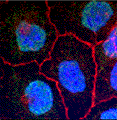Biochemistry, Department of
Document Type
Article
Date of this Version
2008
Citation
Biochim Biophys Acta. 2008 March ; 1781(3): 135–143.
Abstract
Fatty acid transport proteins (FATP) function in fatty acid trafficking pathways, several of which have been shown to participate in the transport of exogenous fatty acids into the cell. Members of this protein family also function as acyl CoA synthetases with specificity towards very long chain fatty acids or bile acids. These proteins have two identifying sequence motifs: The ATP/AMP motif, an approximately 100 amino acid segment required for ATP binding and common to members of the adenylate-forming super family of proteins, and the FATP/VLACS motif that consists of approximately 50 amino acid residues and is restricted to members of the FATP family. This latter motif has been implicated in fatty acid transport in the yeast FATP orthologue Fat1p. In the present studies using a yeast strain containing deletions in FAT1 (encoding Fat1p) and FAA1 (encoding the major acyl CoA synthetase (Acsl) Faa1p) as an experimental platform, the phenotypic and functional properties of specific murine FATP1-FATP4 and FATP6-FATP4 protein chimeras were evaluated in order to define elements within these proteins that further distinguish the fatty acid transport and activation functions. As expected from previous work FATP1 and FATP4 were functional in the fatty acid transport pathway, while and FATP6 was not. All three isoforms were able to activate the very long chain fatty acids arachidonate (C20:4) and lignocerate (C24:0), but with distinguishing activities between saturated and highly unsaturated ligands. A 73 amino acid segment common to FATP1 and FATP4 and between the ATP/AMP and FATP/VLACS motifs was identified by studying the chimeras, which is hypothesized to contribute to the transport function.
Included in
Biochemistry Commons, Biotechnology Commons, Other Biochemistry, Biophysics, and Structural Biology Commons



Comments
Copyright © 2008 Elsevier B.V.